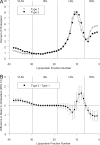Prevalence and determinants of elevated apolipoprotein B and dense low-density lipoprotein in youths with type 1 and type 2 diabetes
- PMID: 18089692
- PMCID: PMC2266957
- DOI: 10.1210/jc.2007-2176
Prevalence and determinants of elevated apolipoprotein B and dense low-density lipoprotein in youths with type 1 and type 2 diabetes
Abstract
Objective: The objective of the study was to assess the prevalence and determinants of elevated apolipoprotein B (apoB) and dense low-density lipoprotein (LDL) in United States youth with type 1 or type 2 diabetes.
Methods: We conducted cross-sectional analyses of apoB concentrations, LDL density, and prevalence of elevated apoB levels and dense LDL from the SEARCH for Diabetes in Youth study, a six-center U.S.-based study of youth with diabetes onset younger than 20 years of age (2657 with type 1 and 345 with type 2).
Results: Among youth with type 1 diabetes, 11% had elevated apoB (>or=100 mg/dl, 1.95 mm/liter), 8% had dense LDL (relative flotation rate<or=0.237), and 12% had elevated LDL-cholesterol (>or=130 mg/dl, 3.36 mm/liter). In contrast, among youth with type 2 diabetes, 36% had elevated apoB, 36% had dense LDL, but only 23% had elevated LDL-cholesterol. Dense LDL and apoB each increased with hemoglobin A1c in both types. Among type 1 diabetics in poor glycemic control (hemoglobin A1c>or=9.5%), 28% had elevated apoB, and 18% had dense LDL, whereas 72% of poorly controlled type 2 diabetics had elevated apoB and 62% had dense LDL.
Conclusions: In youth with type 1 diabetes, elevated apoB and dense LDL were not highly prevalent, whereas elevated apoB and dense LDL were common lipoprotein abnormalities in youth with type 2 diabetes. The prevalence of these risk factors substantially increased with poor glycemic control in both groups, stressing the importance of achieving and maintaining an optimal glucose control.
Figures



References
-
- Libby P, Nathan DM, Abraham K, Brunzell JD, Fradkin JE, Haffner SM, Hsueh W, Rewers M, Roberts BT, Savage PJ, Skarlatos S, Wassef M, Rabadan-Diehl C 2005 Report of the National Heart, Lung, and Blood Institute-National Institute of Diabetes and Digestive and Kidney Diseases Working Group on Cardiovascular Complications of Type 1 Diabetes Mellitus. Circulation 111:3489–3493 - PubMed
-
- Krolewski AS, Kosinski EJ, Warram JH, Leland OS, Busick EJ, Asmal AC, Rand LI, Christlieb AR, Bradley RF, Kahn CR 1987 Magnitude and determinants of coronary artery disease in juvenile-onset, insulin-dependent diabetes mellitus. Am J Cardiol 59:750–755 - PubMed
-
- Laakso M 2001 Cardiovascular disease in type 2 diabetes: challenge for treatment and prevention. J Intern Med 249:391–393 - PubMed
-
- McGill Jr HC, McMahan CA, Zieske AW, Sloop GD, Walcott JV, Troxclair DA, Malcom GT, Tracy RE, Oalmann MC, Strong JP 2000 Associations of coronary heart disease risk factors with the intermediate lesion of atherosclerosis in youth. The Pathobiological Determinants of Atherosclerosis in Youth (PDAY) Research Group. Arterioscler Thromb Vasc Biol 20:1998–2004 - PubMed
-
- Järvisalo MJ, Putto-Laurila A, Jartti L, Lehtimäki T, Solakivi T, Rönnemaa T, Raitakari OT 2002 Carotid artery intima-media thickness in children with type 1 diabetes. Diabetes 51:493–498 - PubMed
Publication types
MeSH terms
Substances
Grants and funding
- M01RR00037/RR/NCRR NIH HHS/United States
- U01 DP000247/DP/NCCDPHP CDC HHS/United States
- M01 RR000069/RR/NCRR NIH HHS/United States
- M01 RR01070/RR/NCRR NIH HHS/United States
- M01 RR000037/RR/NCRR NIH HHS/United States
- U01 DP000244/DP/NCCDPHP CDC HHS/United States
- M01 RR001271/RR/NCRR NIH HHS/United States
- M01 RR08084/RR/NCRR NIH HHS/United States
- M01 RR00069/RR/NCRR NIH HHS/United States
- M01 RR001070/RR/NCRR NIH HHS/United States
- U01 DP000250/DP/NCCDPHP CDC HHS/United States
- M01RR001271/RR/NCRR NIH HHS/United States
- U01 DP000245/DP/NCCDPHP CDC HHS/United States
- DP-05-069/DP/NCCDPHP CDC HHS/United States
- M01 RR008084/RR/NCRR NIH HHS/United States
- U01 DP000248/DP/NCCDPHP CDC HHS/United States
- U01 DP000254/DP/NCCDPHP CDC HHS/United States
- PA00097/PHS HHS/United States
- U01 DP000246/DP/NCCDPHP CDC HHS/United States
LinkOut - more resources
Full Text Sources
Medical
Miscellaneous

